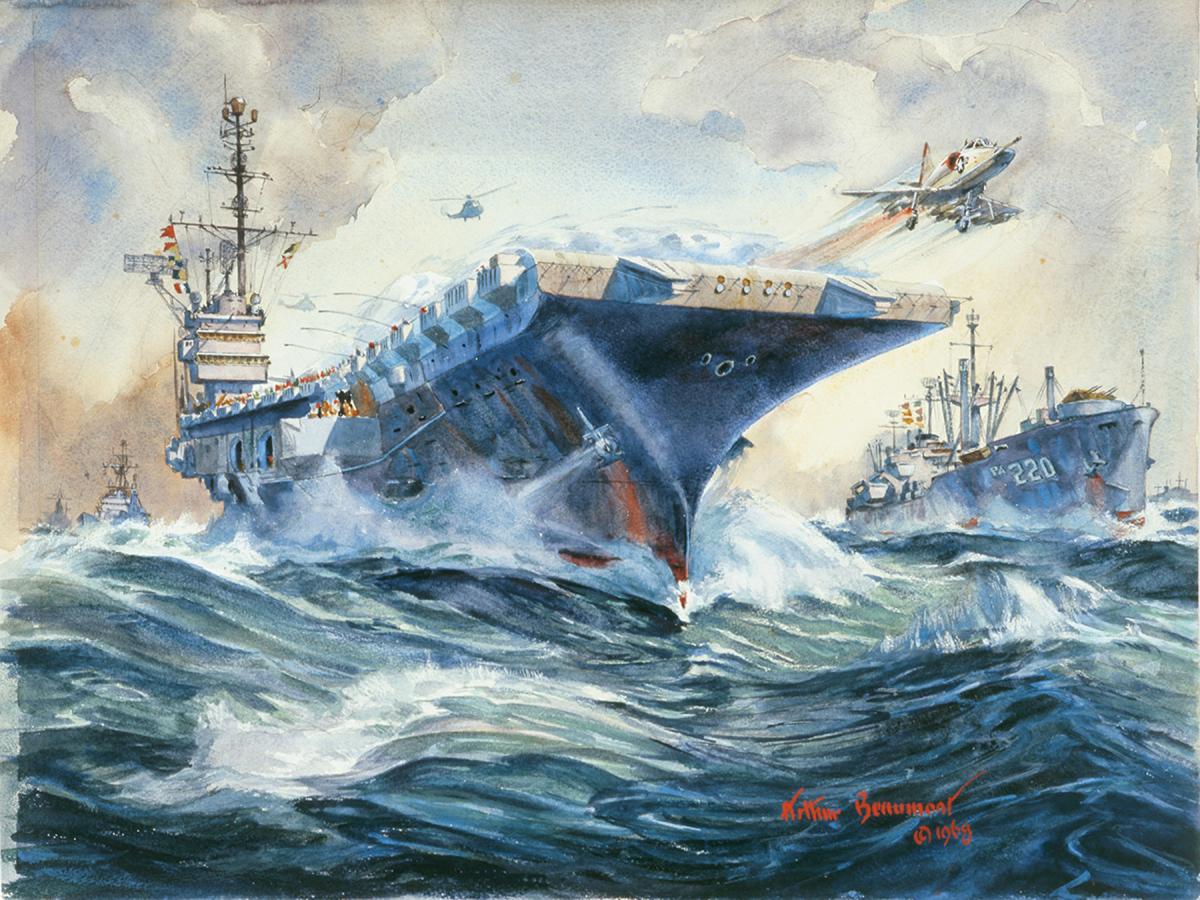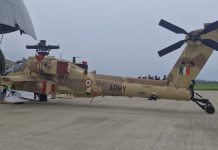The USS Forrestal, the US Navy’s first supercarrier, holds a distinguished place in American naval history as one of the most pivotal warships ever commissioned. Named in honor of James Forrestal, America’s first Secretary of Defense, the Forrestal was launched in 1954 and marked a key leap in carrier design.
It introduced several groundbreaking advancements, most notably the capacity for simultaneous aircraft launches, greatly enhancing its operational efficiency and combat readiness.
Over nearly four decades of service, the USS Forrestal (CV-59) participated in numerous combat operations, consistently demonstrating its value to the Navy’s mission.
Throughout the Vietnam War, the Forrestal was instrumental, especially at Yankee Station in 1967, which served as a vital staging ground for aircraft missions targeting North Vietnam.
However, the Forrestal is perhaps most famously remembered for the tragic accident that occurred on its flight deck on July 29, 1967.
During a busy period of deck operations, an accidental rocket launch from an aircraft led to a series of explosions and fires. The disaster resulted in the loss of 134 lives, injury to 161 crew members, and extensive damage to the ship and its aircraft.
The impact of the 1967 tragedy on the Forrestal was profound. It prompted extensive safety reviews and operational changes within the Navy, leading to the implementation of new procedures designed to prevent similar accidents in the future.
The USS Forrestal: The First Modern Supercarrier
In the 1950-60s, the US Navy had evolved into a formidable surface fleet of supercarriers, a transformation marked by the introduction of three main classes: the Kitty Hawk-class, the Forrestal-class, and the Enterprise-class.
These supercarriers patrolled the world’s oceans, safeguarding American interests with unprecedented power. The USS Forrestal of the Forrestal class was the first of these modern-day “supercarriers.”
Weighing 82,240 tons fully loaded—more than twice the weight of the Essex-class carriers that dominated the Fast Carrier Task Force during World War II—she was also the first aircraft carrier to exceed 1,000 feet in length, measuring 1,070 feet overall.
The Forrestal introduced the angled flight deck to American carriers, allowing simultaneous landing and recovery operations, a significant enhancement in operational efficiency.
During the Vietnam War, the USS Forrestal played a critical role, particularly in 1967, as the United States entered its second year of one of its most costly and ultimately unsuccessful conflicts.

Alongside her sister ships — the USS Ranger (CV-61), the USS Saratoga (CV-60), and the USS Independence (CV-62)—the Forrestal-class carriers, though non-nuclear, proved to be among the Navy’s most successful postwar vessels.
Initially, the carriers supporting the Vietnam War effort were part of the Pacific Fleet. However, as the war intensified and required greater resources, additional assets were needed. This demand led to the deployment of supercarriers from beyond the Pacific.
The USS Forrestal, originally part of the Atlantic Fleet, was repurposed to support the ongoing war effort in Vietnam. The Forrestal could operate up to 80 aircraft of various types, including jets, prop-driven aircraft, and helicopters.
Carrier Air Wing 17 was aboard, featuring an array of aircraft: F-4B Phantom II fighters, A-6A Intruder attack aircraft, A-4E Skyhawk light attack aircraft, RA-5C Vigilante reconnaissance jets, and KA-3B Skywarrior tankers.
John B. Nichols and Barrett Tillman, in their acclaimed book, On Yankee Station: The Naval Air War Over Vietnam, detail the logistical challenges faced by US naval operations against Vietnam.
The geography of Vietnam, with its coastline predominantly along the Tonkin Gulf, rendered the area too small for US carriers to safely operate. As a result, naval operations were conducted from two strategic points in the Pacific Ocean.
The primary location was “Yankee Station,” situated just south of China’s Hainan Island, which served as the launch point for direct strikes against North Vietnam. The secondary was “Dixie Station,” off the coast of South Vietnam, from where airstrikes into Laos and Cambodia were initiated.
The USS Forrestal, exemplifying the might of the US Navy’s supercarriers, arrived at Yankee Station on July 25, 1967, ready to play a crucial role in these operations.
The USS Forrestal’s air wing initiated its first strikes from Yankee Station on the morning of July 26, 1967. Over the subsequent four days, the Forrestal admirably conducted 150 sorties against heavily defended targets deep within North Vietnam, remarkably without losing a single aircraft.
As previously mentioned, the Forrestal-class supercarrier boasted an expansive flight deck, significantly larger than any other conventionally-powered carrier in the American fleet.
Unlike the older Essex-class carriers that saw action in World War II, the aircraft launched from the Forrestal’s flight deck were advanced jets, reflecting the technological advancements and enhanced capabilities of this modern supercarrier.
The Catastrophic Fire Aboard The USS Forrestal
On July 29, 1967, the USS Forrestal and Carrier Air Wing 17 were on their fifth day of airstrikes against Vietnam, marking the ship’s first combat deployment.
The flight deck that day was densely packed with aircraft and personnel, preparing for yet another round of attacks. According to the official accident investigation report, the deck hosted 12 F-4s, 12 A-4s, and 3 A-6s, all armed, fueled, and ready for takeoff.
Some accounts indicated there was barely any walking room between the aircraft, highlighting the intensity and urgency of the operations.
‘Raptor Salad’ For Lunch! US F-22 Raptor Outgunned, Outmaneuvered By German Eurofighter Typhoon?
The atmosphere on the Forrestal was charged with anticipation. The crew was eager to prove the ship’s mettle, having already achieved significant success on this deployment. However, amidst the chaos of preparing for a massive airstrike against North Vietnamese targets, disaster struck.
At 10:51 a.m. local time, a tragic chain of events began when deck handlers switched one F-4 Phantom from external to internal power, inadvertently causing a stray electrical charge to fire a 5-inch Zuni unguided rocket.

The rocket shot out of its pod, severing the arm of a crewman in its path before striking an A-4 Skyhawk. The impact ruptured the aircraft’s side, releasing 3,200 pounds of jet fuel, which ignited almost immediately. Shrapnel from the explosion hit another A-4, causing it to also leak fuel and catch fire.
The resulting fire spread rapidly, intensified by the carrier’s 32-knot sailing speed designed to assist aircraft takeoff. The ship’s crew swiftly initiated emergency protocols, setting General Quarters and securing all doors and hatches to prevent the spread of fire, smoke, and flooding.
Damage-control teams sprang into action, attempting to douse the flames within a minute and a half. However, the situation worsened when a 1,000-pound aerial bomb from the first hit A-4 fell into a pool of burning fuel and exploded.
This explosion was followed by another bomb detonating 14 seconds later, which decimated two firefighting teams, and a third bomb exploding nine seconds after that, halting firefighting efforts for five minutes.
The force of these explosions punctured the flight deck, allowing burning fuel to seep into the hangar and three decks below.
The fire raged uncontrollably, trapping pilots inside their aircraft and causing chaos throughout the ship. Authorities took an entire day to contain the blaze, a task complicated by the initial explosions that had severely damaged the flight deck.
These explosions allowed fuel to infiltrate the lower levels of the USS Forrestal, with subsequent detonations further compromising the structure and killing 50 crew members when one explosion erupted directly above their sleeping quarters.
The destroyers USS Rupertus (DD-851) and George K. MacKenzie (DD-836) played crucial roles in finally subduing the flames, revealing the full extent of the casualties. Many wounded were transferred to the hospital ship USS Repose (AH-16).
The disaster resulted in the tragic loss of 134 sailors, with hundreds more injured. Over 20 aircraft, including F-4Bs, A-4Es, and North American RA-5C Vigilantes, were destroyed, and the aircraft carrier herself suffered damages exceeding $70 million at the time.
On the USS Forrestal, some managed to survive the catastrophe, while others faced a harsher fate. The explosions on July 29, 1967, marked the deadliest incident aboard a US Navy vessel since World War II.
The explosion and fire also nearly claimed the life of Lt. Cmdr. John S. McCain III, who later became a senator and US presidential candidate.
After the catastrophic fire in 1967, the USS Forrestal returned to the East Coast of the United States and underwent a thorough two-year repair process at the Norfolk Naval Shipyard. Once the repairs were completed and the carrier was cleared for duty, it embarked on multiple deployments to the Mediterranean.
The Forrestal played a key role in various operations, including the 1981 Gulf of Sidra incident, where it engaged in military actions in the region. It also participated in Operation Earnest Will in the Middle East and was placed on standby during the Gulf War.
In 1991, the Forrestal provided crucial air support during Operation Provide Comfort, which aimed to aid Kurdish refugees in northern Iraq. Following this mission, the carrier was re-designated as a training vessel and given the hull designation AVT-59. The USS Forrestal continued to serve in this training role until its decommissioning in 1993.
Although there were attempts to maintain the Forrestal as a museum ship, these efforts did not succeed. In 2015, after being in reserve for twenty-three years, the Forrestal was ultimately scrapped, marking the end of a storied and impactful career.
Aftermath
Following the tragic incident aboard the USS Forrestal, the Navy conducted an extensive review of its firefighting and safety procedures. This review revealed several critical issues, including a permissive safety culture, inadequate firefighting skills among sailors, and slow reaction to unexpected accidents.
Under the direction of Rear Adm. Forsyth Massey, the Aircraft Carrier Safety Review Panel, tasked with investigating the disaster, found that a key factor in the accident was “poor and outdated doctrinal and technical documentation of ordnance and aircraft equipment and procedures.” This issue was evident at all levels of command and contributed to the accidental firing of the Zuni rocket.

The investigation report cleared the ship’s command leadership, the commander of Carrier Air Wing 17, and the pilot of the F-4 Phantom—whose Zuni rocket had accidentally discharged—of direct responsibility for the incident.
However, it criticized the squadron commander for “poor judgment and supervisory deficiencies” regarding his ordnance personnel. While the ordnance personnel themselves were considered competent, they were found to be inadequately trained for the critical tasks they were assigned.
The explosions and subsequent fire aboard the USS Forrestal prompted significant changes in naval safety protocols. In response to the disaster, the Navy implemented stricter regulations and enhanced training programs for deck handlers. Additionally, damage-control techniques were significantly improved to better prepare sailors for similar emergencies in the future.
- Contact the author at ashishmichel(at)gmail.com
- Follow EurAsian Times on Google News




